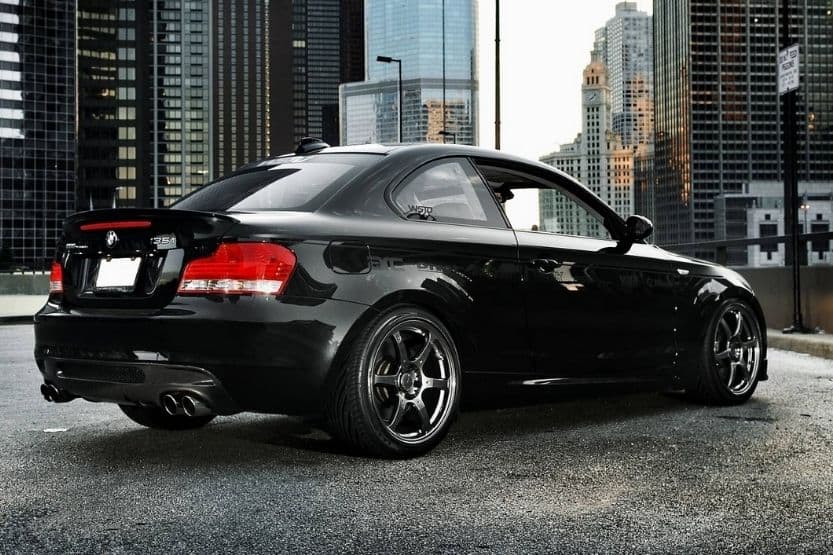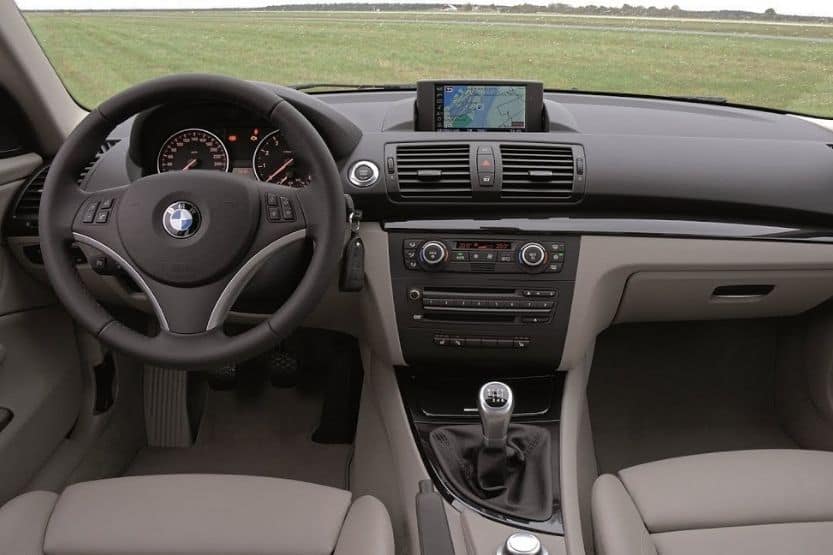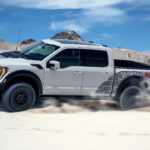The BMW 135i is the most powerful car in the BMW 1-series. The key selling point of the BMW 135i is that it is quite fast and handles just like its bigger and more powerful sibling, the 3-series.
Having a shorter wheelbase makes the BMW 135i a perfect inner-city cruiser. It is easy to maneuver and goes 0-60mph in under 5 seconds.
The 135i is the most powerful car in the BMW 1-series. Many also consider it a good “entry-level” Bimmer for those who want to experience riding one.
Read on to learn more about the BMW 135i, including its key features and specs.
About the BMW 135i

The BMW 135i, the most powerful car in the BMW 1-series, can be both an inner-city cruiser and a weekend getaway car since it has a short wheelbase, is fast, and is easy to maneuver.
The BMW 135i first materialized in the motoring world back in 2007. However, North America got its first 135i the following year.
The BMW 135i was quite a gamble for the company as most other car companies emphasized making larger and more powerful coupes and sedans. On the other hand, BMW went the opposite way, and their gamble paid off quite well.
The BMW 135i originally came in two variants – a 3.0L inline 6-cylinder and the other with twin turbos. It ran from 2007 to 2013. The model continues, but the car received the coveted M-badge (M135i).
BMW 135i Specs and Features
Engine
The BMW 135i had two variants – one with an N55 3.0L inline 6-cylinder and the other with the same twin turbochargers. The engines produced 270hp and 300hp, respectively.
A multi-point electronic fuel injection system feeds the engine. Fuel mileage will vary, but on average, one can get around 20 miles per gallon and a range of up to 350 miles on a full tank with a 14-gallon capacity.
Transmission
The BMW 135i came with a 6-speed automatic transmission, which you can shift to semi-automatic paddle-shifters if you wish to, and a 6-speed manual. Both variants are rear-wheel-driven.
The automatic gearbox of the 135i provides instantaneous and near-perfectly linear acceleration that will push the driver into the seat. Also, because the shifting is so smooth, there is almost no loss in power between gears.
Acceleration – BMW 135i 0-60
The twin-turbo, inline 6-cylinder engine of the 135i launches this compact sports car from 0-60mph in just 4.7 seconds, and it clocked an impressive 107mph on a quarter-mile race track.
It is awe-inspiring for a stock Bimmer. The 135i’s twin-turbo six-cylinder engine almost effortlessly accelerates this car to triple-digit speeds from a standing start.
Fuel Economy
Considering the size of the 3.0L engine and the overall compact size of the 135i, it is no wonder that this sportscar has a relatively excellent fuel mileage.
Highway driving can get you an impressive 20 miles per gallon, and it would, of course, dip considerably when driving in the city. However, your mileage may vary.
Suspension
The 135i comes with a 4-wheel independent suspension, with the front being MacPherson struts and the rear being multi-link for better traction. Both the front and the rear axles come with stabilizer bars. The shocks also have a lot of travel distance, promoting a comfortable ride.
Handling
The 135i has a total length of 171.7 inches, with a wheelbase of just 104.7 inches. This short wheelbase provides this car with a nice tight turning radius of just 35.1 feet.
This means you might not need to make that many 3-point turns anymore. Moreover, the 135i comes with front and rear ventilated disc brakes featuring 4-wheel ABS for smoother braking even when done abruptly.
Safety Features
As with almost all modern BMW vehicles, the 135i came stock with many different safety features, like dual airbags. This model has a passenger occupant sensor, which means that the passenger side airbag will not deploy when there is no passenger.
The 135i has “adaptive headlights,” which is cool, especially in 2008. This means that the headlights automatically level themselves. You will also notice its built-in dusk sensor, which turns on the lights if it gets too dark outside.
Interior
You will get all the “basic” trimmings of a Bimmer when you peek inside the 135i. The dashboard has two large analog dials for the speedometer and the tachometer. You will also notice a large center console for the stereo oriented towards the driver.
The transmission creates a large central bump that gives enough room for the two pedals of the automatic variant barely, and it gets even more cramped in the manual.
Sound System
The 135i came with a standard BMW stereo system, which does sound great. The radio has an orange backlit display, and you can connect your phone to it via Bluetooth (which was quite groundbreaking at the time).

Another neat thing about the 135i’s standard stereo is that it can play HD radio, and the CD player can also read MP3 files.
Seating Capacity
The 135i is a compact sports car, so you need to lower your expectations regarding passenger capacity as it can barely fit four persons due to the back seats being so cramped. The front seats are quite roomy, though, with more than enough leg room if you slide the seats back.
Storage
The trunk provides ample storage because the 135i is a compact sportscar. You can probably fit one or two small suitcases. However, you can fit more luggage if you fold down the backrest of the rear seats.
Below is an excellent BMW 135i review that looks at all its specs and features:
Pros and Cons of the BMW 135i
Pros
There is a lot to praise about the BMW 135i, and let’s start with the engine. Remarkably, the BMW engineers could cram a huge, 3.0L engine and twin turbos into the bonnet of a shrunk 3-series car.
You will discover that there are only little spaces left; almost every square inch is occupied.
The interior of the 135i is also nice. It has a minimalist vibe, and everything looks clean. The instrument cluster has large gauges that are easy to read, and the warning lights are grouped in the center, making it easier to find out if there is anything wrong with the car.
Another neat (optional) feature of the 135i is the touchscreen navigation system. Because there isn’t much room left on the center console, the navigation screen pops out from the dashboard center.
Cons
Ask any BMW owners, and they will tell you that these cars are prone to mechanical issues, expensive ones at that. The 135i is not an exception. The most common problem is malfunctioning water pumps, which often lead to the engine overheating.
Another common issue about the 135i is that there would be a long lag before the car goes forward when stopped at a traffic light. Sometimes, even if you floor the gas pedal, it will still not respond until after a few seconds have passed.
Many have a complaint about the 135i: they bothered to put in two rear passenger seats in an already compact coupe. Try sitting in the back of a 135i, and there is an excellent chance that regardless of your height, your knees will hit the backrest of the driver and passenger side seats.
Many people like how the BMW 135i looks, but you can also find several BMW fans who hate the design, and they have a reason and point for it. The 135i’s design was the brainchild of designer Chris Bangle, who came up with the design for the ugliest 7-series car ever, the E65.
One of the design elements that many people seem to have an issue over is the sloping sides and how the car could not decide if it was a coupe or a hatchback, so it just stopped somewhere in between.
Aftermarket Parts to Make the 135i Even Better
Although the BMW 135i is already a beast while stock, it can always be better. If you are truly invested in making it even more of a monster, there are a couple of aftermarket modifications that you could bolt onto the 135i to make it go vroom.
Here are just some of them:
1. Performance Intake
Installing a performance air intake system will allow the 135i’s N55 engine to receive more air, leading to the twin-turbo spooling faster and more power is gained from the engine.
Adding a performance intake will add at least ten horsepower. Aside from that, it can make the engine sound a lot nicer.
2. Front-Mounted Intercooler
Although having twin turbochargers gives the 135i many perks, the biggest downside is that they produce a lot of heat. The more the turbochargers work, the more heat they produce.
This can lead to a drastic increase in IAT (Intake Air Temperatures), which causes the ECU (Engine Control Unit) to pull down the turbos’ timing and boost. The result would be a significant loss of power.

To counteract the amount of heat produced by the turbos, you will need a bigger turbo intercooler. The stock one is a tad too small for the task. Since there is not that much room in the engine bay, you should opt for a front-mounted intercooler.
A bigger intercooler will not just add around 10-15hp, but it will also eliminate heat soak and prevent engine knocking.
3. Charge Pipe Replacement
This modification won’t be adding more horsepower, but it is essential if you want your 135i to run properly for years to come. The BMW 135i’s OEM charge pipe is one of its biggest weaknesses.
The stock charge pipe is made entirely of plastic, making it a literal ticking timebomb, especially if the twin turbos are pushed to their limits regularly.
Replacing the original charge pipe with a performance metal will ensure that the 135i can easily handle the additional boost.
Even though good quality replacements are expensive, they are still cheaper than waiting until the original charge pipe explodes, resulting in even more expensive damages.
Why Do People Love the BMW 135i?
The BMW 135i is often sought after by BMW enthusiasts despite its flaws. Even though it is not the best-looking of the bunch, it is still one of the best in the Bavarian car maker’s stable when it comes to performance.
The BMW 135i might be a compact coupe, but it does have a monstrous engine crammed inside it, which propels the vehicle from 0-60mph in under 5 seconds, unmodified. You can add a couple of basic modifications to it, and it will surely go flying across the race track.
Also, even though its looks are somewhat of an acquired taste, many people still unironically like its unique look. The front of the 135i is identical to other Bimmers, particularly the 3-series, but look at it from the side, and you will see a distinct difference.
Suppose you like how the 135i; no one would hold it against you. Besides, many people would agree with you.
Conclusion – BMW 135i
The BMW 135i, the most powerful car in the BMW 1-series, can be both an inner-city cruiser and a weekend getaway car due to its characteristics such as:
- Short wheelbase,
- Quite fast, and
- Easy to maneuver.
The BMW 135i is one of the most infamous models from the carmaker, and I mean it in a good way. Although the design of the 135i leaves a lot to be desired, its uniqueness makes it appealing.
Also, the BMW 135i is a beast when it hits the pavement. The twin-turbo n55 engine packs a punch and can bring you joy when driving around the track.
BMW 135i 0-60: The twin-turbo, inline 6-cylinder engine of the 135i launches this compact sports car from 0-60mph in just 4.7 seconds. It also clocked an impressive 107mph on a quarter-mile race track.
If you are interested in getting a BMW 135i, be aware that it comes with all the usual problems attached to all Bimmers, but it is also a fun ride when it feels inclined to behave.
Related reading:
BMW SULEV – What Is It? [Benefits, Problems, and the Warranty]


![Are BMWs Reliable? [What Are the Most Reliable BMW Models?] are bmws reliable](https://roadsumo.com/wp-content/uploads/2022/06/are-BMWs-reliable-150x150.jpg)
![Ford 6.2 Engine Problems [5 Most Common and How to Fix] ford 6.2 engine problems](https://roadsumo.com/wp-content/uploads/2021/06/ford-6.2-engine-problems-150x150.jpg)
![5.7 Hemi Problems [7 Most Common] 5.7 Hemi Problems](https://roadsumo.com/wp-content/uploads/2021/11/5.7-Hemi-Problems-150x150.jpg)
![Most Reliable Sports Cars in the World [Top 10] most reliable sports cars in the world](https://roadsumo.com/wp-content/uploads/2022/10/most-reliable-sports-cars-in-the-world-150x150.jpg)
![Most Reliable Luxury Cars [Top 10] most reliable luxury cars](https://roadsumo.com/wp-content/uploads/2022/10/most-reliable-luxury-cars-150x150.jpg)


